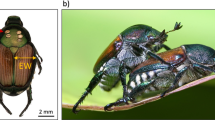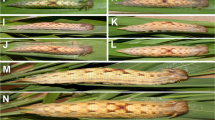Abstract
Two larval instars of Carcinops pumilio (Erichson) were identified from a frequency distribution of the head capsule measurements. The total developmental time from egg to adult emergence averaged 20.5 ± 0.1 days at 30 °C. The 2nd instar was the longest, accounting for 39% of the total development time. The 1st instar larvae sustained the highest mortality of 26% whilst there was no mortality in the pupal stage. The immature stages sustained about 50% mortality before adult emergence. The adult females of C. pumilio can live for 140 days and the rate of survival was high in the young adults but decreased as the beetles aged. Newly emerged adults survived for 25.5 ± 0.4 days without feeding. The sex ratio was 0.48 females: 0.52 males. The intrinsic rate of natural increase (rm) was 0.065, the generation time (T) was 50.019 days and the net reproduction rate (Ro) was 20.191.
Similar content being viewed by others
References
J.R. Anderson J.H. Poorbaugh (1964) ArticleTitleObservation on the ethology and ecology of various Diptera associated with Northern California poultry ranches J. Med. Entomol. 1 131–147
R.C. Axtell (1970) ArticleTitleIntegrated fly-control program for caged-poultry houses J. Econ. Entomol. 63 400–405 Occurrence Handle5441229
R.C. Axtell (1985) ArticleTitleFly management in poultry production: cultural, biological and chemical Poultry Sci. 65 657–667
R.C. Axtell (1990) Potential of biocontrol for livestock and poultry pests D.A. Rutz R.S. Patterson (Eds) Biocontrol of Arthropods Affecting Livestock and Poultry Westview Press San Francisco
J.A. Conway (1973) ArticleTitleThe micro-fauna of California-system poultry houses in Britain Brit. Poultry Sci. 14 213–216
R.A. Crowson (1981) The Biology of the Coleoptera Academic Press New York.
M.G. Flecther R.C. Axtell R.E. Stinner L.R. Wilhoit (1991) ArticleTitleTemperature-dependent development of immature Carcinops pumilio (Coleoptera: Histeridae), a predator of Musca domestica (Diptera: Muscidae) J. Entomol. Sci. 26 99–108
C.J. Geden (1984) Population dynamics, spatial distribution, dispersal behaviour and life history of the predaceous histerid, Carcinops pumilio (Erichson), with observations of other members of the poultry manure arthropod community University of Massachusettes Amherst.
C.J. Geden J.G. Stoffolano (1987) ArticleTitleSuccession of manure arthropods at a poultry farm in Massachusetts, USA, with observations on Carcinops pumilio (Coleoptera: Histeridae) sex ratios, ovarian condition and body size J. Med. Entomol. 24 212–220
C.J. Geden R.E. Stinner R.C. Axtell (1988) ArticleTitlePredation by predators of the house fly in poultry manure: effects of predator density, feeding history, interspecific interference, and field conditions Env. Entomol. 17 320–329
C.J. Geden L. Smith S.J. Long D.A. Rutz (1992) ArticleTitleRapid deterioration of searching behaviour, host destruction and fecundity of the parasitoid Muscidifurax raptor (Hymenoptera: Pteromlidae) in culture Ann. Entomol. Soc. Am. 85 179–187
H.E. Hinton (1945) ArticleTitleThe Histeridae associated with stored products Bull. Entomol. Res. 35 309–340
P.E. Hulley (1983) ArticleTitleA survey of the flies breeding in poultry manure, and their potential natural enemies J. Entomol. Soc. South. Afr. 46 38–47
P.E. Hulley (1986) ArticleTitleFactors affecting numbers of Musca domestica Linnaeus (Diptera: Muscidae) and some other flies breeding in poultry manure J. Entomol. Soc. South. Afr. 49 19–27
P.E. Hulley M. Pfleiderer (1988) ArticleTitleThe Coleoptera in poultry manure potential predators of the house fly, Musca domestica Linnaeus (Diptera: Muscidae) J. Entomol. Soc. South. Afr. 51 18–29
P.B. Morgan R.S. Patterson D.E. Weidhaas (1983) ArticleTitleA life-history study of Carcinops pumilio Erichson (Coleoptera: Histeridae) J. Georgia Entomol. Soc. 18 353–359
D.G. Pfeiffer R.C. AxtellL (1980) ArticleTitleColeoptera of poultry manure in caged-layer houses in North Carolina Environ. Entomol. 9 21–28
R.W. Poole (1974) An Introduction to Quantitative Ecology McGraw-Hill New York
P. W. Price (1984) Insect Ecology EditionNumber2 John Wiley & Sons Inc. New York
P.W. Price (1997) Insect Ecology EditionNumber3 John Wiley & Sons Inc. New York
Smith, K.A. 1975. Observations on the Life History, Ecology and Behaviour of Carcinops pumilio (Erichson). MSc. Thesis, Department of Entomology, University of New Hampshire, Durham
G.M. Toyama J.K. Ikeda (1976) ArticleTitleAn evaluation of fly breeding and fly parasites at animal farms on leeward and central Oahu Proc. Hawaii. Entomol. Soc. 22 353–368
T.F. Watson (1964) ArticleTitleInfluence of host plant condition on population increase of Tetranychus telarius (Linnaeus) (Acarina: Tetranychidae) Hilgardia 35 237–322
Author information
Authors and Affiliations
Corresponding author
Rights and permissions
About this article
Cite this article
Achiano, K., Giliomee, J. Biology of the House Fly Predator Carcinops pumilio (Erichson) (Coleoptera: Histeridae). Biocontrol 50, 899–910 (2005). https://doi.org/10.1007/s10526-005-3632-4
Received:
Accepted:
Issue Date:
DOI: https://doi.org/10.1007/s10526-005-3632-4




